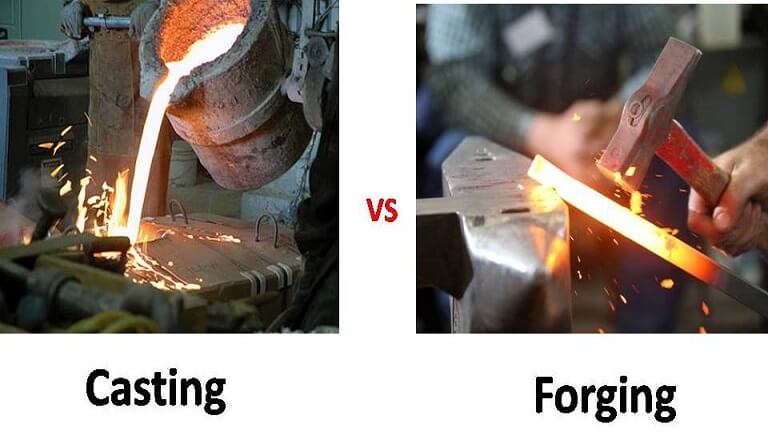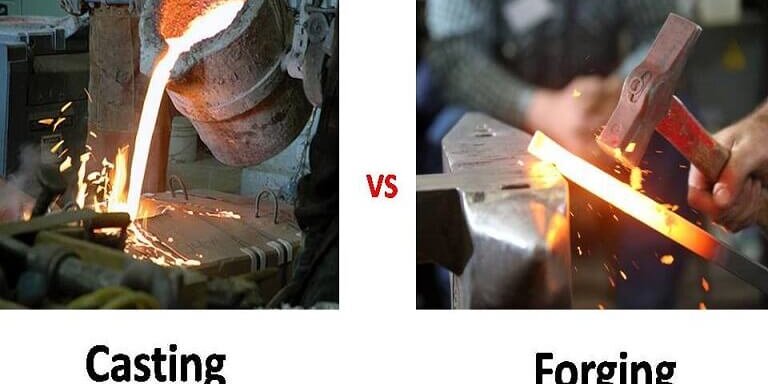Contents
Investment Casting Vs. Forging
Casting and forging are the most used methods of manufacturing metal parts. In most cases, clients will often want to compare investment casting and forging to find the most suitable method of producing their components. As much as investment casting and forging are all effective for metal manufacturing, they have advantages and disadvantages that can help you know which method is more suitable for your projects.
So, what precisely is investment casting or forging? This article outlines the differences between investment casting and forging.
What Is Investment Casting?
Investment casting, also called precision casting or lost foam casting, is a metal casting technique used to form metal components by pouring molten metal into molds and leaving it to solidify. In investment casting, the molten metal is poured into molds made to replicate the desired product’s form, size, and shape. These molds are made using wax. Other types of casting include die casting, centrifugal casting, sand casting, and continuous casting.

What Is Forging?
Forging, also known as drop forging, is a technique used to produce different material products in their solid-state. Forging does not require melting the material or molds. However, the material is shaped using compressive forces, such as hitting or hammering. Forging is most suitable when the desired product is expected to have high material strength. During forging, the material is mainly heated and then compressed using a hammer or die.
What Is The Difference Between Investment Casting And Forging?
There are many ways to identify the differences between forging and casting. For instance, it is easier to differentiate the two by looking at the features of each technique.
Forging produces metal components with high strength than casting. Metal parts produced by forging do not shatter easily. This strength is derived from the compression force used to force the material into shape. The grains of the material is stretched during forging. This process aligns the grains in a single direction, creating a solid bond.
However, forging is only possible up to a specific size. For instance, hitting metal into shape is more daunting and tiresome than casting. This is primarily because you will need to alter the original shape of the metal. This means you can only forge metals of a particular size. The thicker the metal, the harder the forging.
On the other hand, casting requires the metal to be molten first before filling it in a mold, die, or cavity. This technique ensures you can produce materials with more complex forms and shapes. Typically, you can cast up to 200 tons of materials. Casting is also more affordable than forging.
Casting Vs. Machining Pros and Cons
Casting and forging have advantages and disadvantages that make them suitable or not suitable for specific projects.
Investment Casting Advantages
- More affordable for low volume production since it requires less tooling
- Useful when manufacturing a wide variety of ferrous and non-ferrous metals
- Can produce metal components with more complex shapes and forms
- Requires less machining
- Produces material with excellent surface finish
Investment Casting Disadvantages
- Longer cycle times
- The size of parts is limited
- Larger parts come with questionable dimensional precision
- Tends to be more manual and can lead to higher costs in the long run
Forging Advantages
- The cost of production is typically low
- Shorter cycle times
- More affordable when producing large volumes of materials
Forging Disadvantages
- High tooling cost
- Frequent replacement of tooling can be tiresome
- Alloys used are limited
- Products have low dimensional precision
- Cannot produce more complex components
Casting Vs. Forging; Which Is Better?
As stated earlier, forging and casting have differences that make them better for particular projects. Here is how to identify which is better between forging and casting:
a. Casting Vs. Forging Definition
Casting is a technique where molten metal is poured into a cavity, die, or mold and left to solidify to produce the desired metal component.
Forging is a metal-making technique where compressive force is used to shape the metal into the desired form.
b. Casting Vs. Forging Material Strength
Metal parts made by casting have low strength since the material is poured into a mold that gives it its shape freely.
Metal parts made by forging have high mechanical strength since hammering or hitting gives the material a more definite grain structure.
c. Casting Vs. Forging Uniformity
Metal components made through casting typically do not have a uniform shape or structure.
Forged products have a consistent and uniform structure.
d. Casting Vs. Forging Size Limitations
Casting can be used to produce parts of any size or shape.
Forged materials are limited in size and weight since it requires more force to shape larger and heavier metals.
e. Casting Vs. Forging Complexity
Cast materials have more complex shapes, forms, and structures.
Forged materials are more uniform and simple.
f. Casting Vs. Forging Cost
The cost of casting is relatively lower.
Forging costs can be higher due to more tooling required.
g. Casting Vs. Forging Shape Suitability
Casting is more suitable for making metal parts with cavities or hollow shapes.
Forging cannot produce materials with hollow shapes or cavities.
Investment Casting Vs. Machining
Investment casting can replace various machining processes, such as milling, turning, and grinding. This is primarily because investment casting can achieve near net shape, thus eliminating the need for machining.
Investment casting allows you to achieve higher production volumes at reduced costs and wastage. Additionally, investment casting is more suitable for more complex applications and standards that cannot be achieved through forging or machining. Lastly, investment casting produces metal parts with high tolerance, making it more affordable for producing products such as valves.
The Bottom Line
How can you identify the best method between investment casting and forging? You need to figure out if your products will perform better when cast or forged. Accordingly, you can look into the tradeoff between the two options. Some products tend to be more effective when produced using a particular process.
Therefore, it is essential to look into the factors that differentiate investment casting from forging. You may want to consider the cost, strength, material waste, and tolerance. This way, you can determine what will work best for you.

